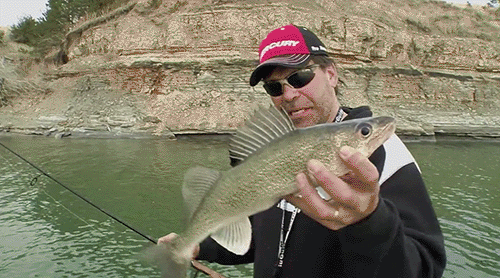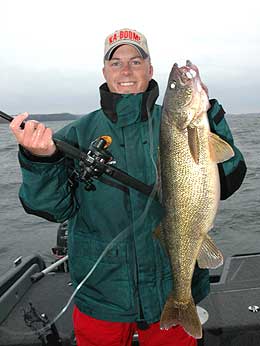With the help of a select handful of the country’s top walleye pros, Mark Boyd works to find out “What makes a good walleye crankbait?” … and gets answers that we can all use to become better walleye anglers.

Plugs, wobblers, hard-baits … what ever you want to call them, crankbaits are a mainstay in most any walleye angler’s arsenal. That has not always been the case, but since the inception of professional walleye fishing, the proof is in results … cranks catch walleyes!
That’s not to say that all hard baits will catch walleyes however. They come in such a wide array of styles, colors and sizes that a trip down the isle of your nearest tackle retailer can be an awe-inspiring, mind-boggling, or even dumb-founding experience … the selection seems endless! In order to distinguish “walleye crankbaits” from the rest, one needs to understand that these lures are specialized tools, and must meet a particular set of criteria.
Professional walleye anglers understand this, and when asked what makes “the grade” for targeting walleyes, one point comes up again and again, “The action of the lure is the #1 factor”, explains Gary Parsons, “It has to have a top-to-bottom roll as opposed to the side-to-side wobble of baits more conducive to say, catching bass.” This type of action is important because it maximizes the bait’s “side-flash”, giving it the sight attraction characteristics that trigger walleyes.
Color of the lure plays a key role here … a high-contrast color pattern such as Silver sides/Black back, emit an “on again, off again” sort of flash pattern that best mimics live bait in the water. For this reason, color patterns that include bright colored sides and dark backs are steady producers.
What’s the best way to determine if a crankbait has the “top-to-bottom roll” action a walleye angler is looking for? “Look at the eyes of the lure as the bait runs through the water.” claims walleye pro Keith Kavajecz, “If the eyes move up and down as opposed to side-to-side, then you’ve got a lure that fits into the “walleye category” of crankbaits.”
Is that all there is to it? Find the lure with the right action and start catching fish? Not by a long shot! All you’ve done to this point is narrow down your choice of lures to those that have the right over-all action for walleyes. To break things down even further, you need to categorize your walleye lures according to time of year, or perhaps more appropriately, water temperature.
Most walleye crankbaits can be put into one of three “action sub-categories”, subtle action, moderate action and high action. Which sub-category you choose from is primarily determined by the water temp you’re dealing with. In cold water, that is water below the 50º mark, subtle action baits are most popular. These would include the family of lures often referred to as “stick-baits” or “minnow baits”. A few of the most popular models would include the Berkley Flicker Minnow, original Floating Rapala and Husky Jerk, Storm ThunderStick, and the Smithwick Rattlin’ Rouge. “The Rapala Husky Jerk is one of the best cold water trolling crankbaits there is.” claims veteran walleye pro Scott Fairbairn, “You can fish this bait in a variety of depths, either by using Snap Weights or lead core line, and fish it ultra-slow – which is critical in cold water.” The use of a weighting system with subtle action lures is common, since most are designed as shallow running baits. Fairbairn adds “The fact that the Husky Jerk is a suspending bait also adds to its appeal, because you can hang the lure right in the fishes’ faces at times to trigger sluggish biters.”
As the water temps warm into the 50 and 60 degree range, moderate action lures come more into play. By design, this group of baits will generally sport a slightly deeper diving lip, and a more aggressive action than the subtle action cranks. This is the largest group of walleye crankbaits and many walleye pros divide this group of baits even further to distinguish lure profile between shad shaped baits and smelt shaped baits, in order to Berkley Flicker Minnow help them “match the hatch” depending on the body of water their fishing. A good selection of “shad” style lures may include such models as the Berkley Flicker Shad, Rapala Shad Raps (including the new Rattling/Suspending Shad Raps), and Berkley Frenzy Divers. For bodies of water where the forage takes on a more long and narrow profile great choices would include Berkley Frenzy Diving Minnows, Storm Deep ThunderSticks (DTS09 and DTS12), Bomber Long A’s, Deep Diving Husky Jerks and Reef Runner Deep Divers.
 The beauty of moderate action lures is that they are very versatile, producing well at slow speeds, fast speeds, and anywhere in between. “A lure that is effective at any speed gives you much more room for experimentation.” points out Kavajecz, “Trolling speed is one of those fine-tuning factors that an angler needs to dial in on when patterning walleyes. In the summer months it can be tough because one day they want it slow, and the next day they’re in the mood to chase down torpedoes.”
The beauty of moderate action lures is that they are very versatile, producing well at slow speeds, fast speeds, and anywhere in between. “A lure that is effective at any speed gives you much more room for experimentation.” points out Kavajecz, “Trolling speed is one of those fine-tuning factors that an angler needs to dial in on when patterning walleyes. In the summer months it can be tough because one day they want it slow, and the next day they’re in the mood to chase down torpedoes.”
Once water temperature tops the 70º mark, things really begin to heat up for crankbaits. Moderate action baits can still be good producers, but there are instances when a lure with a highly aggressive action is a better choice. Dave’s KaBoom Baits Mean StreakHigh action baits like Dave’s KaBoom Baits Mean Streaks and Winning Streaks, Storm Hot’N Tots, and Rapala DT Series cranks go beyond the basic “top-to-bottom roll” and add in a bit of extra wobble to the dance. When trolling vast open waters like the Great Lakes for aggressive summertime walleyes, these cranks can ring a fish’s dinner bell from a long way off. Metal-lipped lures like the Mean Streak have the added attraction of flash emitted from the metal bill, which is a big plus in drawing in sight-feeding oriented walleyes found in large, clear water environments.
Crankbait selection doesn’t stop there … there are specific color patterns to consider for one thing. While high contrast patterns were mentioned earlier, don’t think that the ole’ stand-by Silver/Black Back will fit every scenario. FireTiger patterns are dynamite in stained water (which still fits the “high-Glass Perch Shad Rapcontrast scheme being basically a chartreuse side, dark colored back pattern), and new-age finishes like Rapala’s RapFlash Holographic patterns and their new “Glass” finishes are proving “flashy” can come in many colors. “I’ve fished in enough tournaments to see color pattern play a big role in success.” says PWT Pro Rick Olson, “You can run four different colors of the same bait through the same bunch of fish, and only get bites on one. Why? … I would be a rich man if I could truly answer that! It’s best to just let the fish dictate what they want.”
Berkley Flicker Shad Built-in rattles is another feature of many popular walleye crankbaits. Parsons points out, “It used to be that you’d only consider using a rattling style bait in dark or stained water, but I know from experience that clear water walleyes will chase a down a lure from a long ways to find out what all the racket’s about. The fish-catchingest lures I’ve used in some time are Berkley’s Flicker Shads, and the fact that these baits all have rattles is no coincidence, I guarantee you.”
I asked many of today’s top walleye pros what crankbait would they choose if they could only fish with one, and the answers were surprisingly similar … “It Depends …” was the most common answer. They all came back with their own questions like, “On what body of water? What time of year? and What’s the weather like?” I guess the best answer is “The one that catches the most fish!” That’s a criteria that’s tough to argue with.










